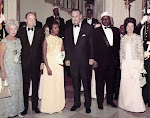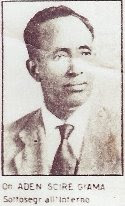Ethnic Somalis are united by language, culture, devotion to Islam, and to a common ancestor, the Samaale, or Samaal. Genealogical ties have also provided the basis on which divisions among Somalis have occurred, division historically being more common than unity.
The overwhelming majority of Somalis trace their genealogical origin to the mythical founding father, Samaale or Samaal. Even those clan-families, such as the Digil and Rahanwayn in southern Somalia, whose members in many cases do not trace their lineage directly to Samaal, readily identify themselves as Somalis, thereby accepting the primacy of Samaal as the forebear of the Somali people. By language, traditions, and way of life, the Somalis share kinship with other members of the Eastern Cushitic groups of the Horn of Africa, including the Oromo, who constitute roughly 50 percent of the population of Ethiopia; the Afar (Danakil), who straddle the Great Rift Valley between Ethiopia and Djibouti; the Beja tribes of eastern Sudan; and the Reendille (Rendilli) and Boni (Aweera) peoples of northeastern Kenya (see The Somalis: Their Origins, Migrations, and Settlement , ch. 1).
Genealogy constitutes the heart of the Somali social system. It is the basis of the collective Somali inclination toward internal fission and internecine conflict, as well as of the Somalis' sense of being distinct--a consciousness of otherness that borders on xenophobia.
The major branches of the Somali lineage system are four overwhelmingly pastoral nomadic clan-families (the Dir, Daarood, Isaaq, and Hawiye, who are collectively denoted by the appellation of Samaal), and two agricultural ones (the Digil and Rahanwayn) (see fig. 4). As Israeli political scientist Saadia Touval noted in his brief study of Somali nationalism, these six clan-families correspond to the "Old Testament version of the tribal segmentation of the children of Israel." Like the children of Israel, the children of Samaale, with minor exceptions, are politically acephalous and prone to internal schism and factionalism. Although the modern Somali state, which is largely a creation of European colonialism, tried vainly to exercise a measure of centralized authority through the armed forces and the civilian bureaucracy, most Somalis continued to give greater political and emotional allegiance to their lineages. In 1992 the centralized state constructed on the Somali Peninsula had all but disintegrated into its constituent lineages and clans, whose internecine wars were drenching the country in bloodshed.
The Dir, Daarood, Isaaq, and Hawiye, which together make up the Samaal clans, constitute roughly 75 percent of the population. Most Samaal clans are widely distributed pastoralists, although a growing minority of them are settled cultivators. The Digil and Rahanwayn constitute about 20 percent of the population. They are settled in the riverine regions of southern Somalia and rely on a mixed economy of cattle and camel husbandry and cultivation.
Clan-families, too large and scattered for practical cooperation, in the past had no real political or economic functions. However, with the renewal and intensification of clan feuding in the wake of Siad Barre's fall from power in early 1991, the clan-families assumed crucial significance as nascent political parties pitted against one another along tribal lines in a disastrous civil war (see Lineage Segmentation and the Somali Civil War , this ch.). Membership in clan-families, primary lineages, and clans was traced through males from a common male ancestor.
Descent as the basis of group formation and loyalty was modified, but not overridden, by the principle of heer. Membership in the same clan or lineage did not automatically entail certain rights and obligations. These were explicitly the subject of treaties or contracts. Thus, some clans in a clanfamily might unite for political and military purposes, and some lineages within a clan might associate to pay and receive blood compensation in cases of homicide, injury, and other offenses. These alignments had a kinship base in that members often descended from a particular wife of a common ancestor, but units formed by contract or treaty could be dissolved and new ones formed.
The traditional social structure was characterized by competition and conflict between descent groups. Among the Samaal, the search for pasture and water drove clans and lineages physically apart or pitted them against each other. The Digil and Rahanwayn (cultivators of the south) had a history of warfare over trade and religious matters and of fighting the encroachments of camel-herding nomads.
Whatever their common origin, the Samaal and the Digil and Rahanwayn evolved differently as they adapted to different physical environments. With some exceptions, the Samaal lived in areas that supported a pastoralism based mainly on camels, sheep, and goats. The Digil and Rahanwayn lived in the area between the rivers where they raised cattle and came to enslave the nonSomali cultivators who were there when they arrived. After the demise of slavery in the 1920s, the Digil and Rahanwayn themselves undertook cultivation.
The Samaal considered themselves superior to settled Somalis. Lineage remained the focal point of loyalty for pastoral nomads. The Digil and Rahanwayn developed a heterogeneous society that accorded status to different groups on the basis of origin and occupation. Group cohesion developed a territorial dimension among the settled agriculturists.
Relations between and within groups underwent changes during the colonial era and after independence. Armed conflict between descent groups (or in the south, territorial units) became rare during the two decades (the 1960s and 1970s) following independence. However, in the 1980s and early 1990s, as President Siad Barre incited and inflamed clan rivalries to divert public attention from the problems of his increasingly unpopular regime, Somali society began to witness an unprecedented outbreak of inter- and intra-clan conflicts. The basic modes of social organization and relations persisted, however, particularly among the pastoral nomads. Moreover, national politics were often operated in terms of relationships between segments of various kinds.
Several thousand persons, including some ethnic Somalis, were integrated into traditional society but were not included in the six clan-families. Among them were Somali clans descended from ancestors predating or otherwise missing from the genealogies of the six clan-families. Others were lineages of relatively unmixed Arab or Persian descent, often much inbred; most members of these groups lived in the coastal towns. Such lineages or communities had varying relationships with local Somalis. Some were clients subordinate to Somali groups; others were independent entities in the larger towns. A second category consisted of the so-called habash, or adoon, cultivators or hunters of preSomali origin who lived among the Rahanwayn and Digil in the interriverine area. A third category consisted of occupationally specialized caste-like groups, members of which were attached to Somali lineages or clans. Finally, until the last were freed in the 1920s, there was a small number of slaves attached to both pastoral and sedentary Somali groups, but of greater economic importance among the latter.
Professor Saadia Touval






.jpg)











No comments:
Post a Comment